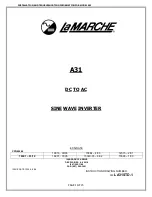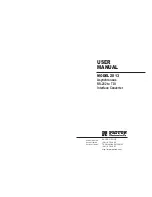
INSTALLATION AND TROUBLESHOOTING INFORMATION FOR MODEL A31
PAGE 10 OF 15
10.0. TROUBLESHOOTING
10.1 GENERAL INFORMATION
This troubleshooting guide is intended for use only by trained service personnel or experience
electricians.
CAUTION: HAZARDOUS AC AND DC VOLTAGES ARE PRESENT IN THE UNIT!
10.2 PRELIMINARY CHECKS
Before proceeding with any testing or trouble shooting, give the unit a general inspection.
Check for the following:
Check for shipping damage, loose connections, broken wires, etc.
Check the DC input cables to make sure they are proper polarity and secure. The DC voltage
input must be above 2 volts per cell (lead acid) and 1.3 volts per cell (nickel cadmium).
Check the bypass line connections to make sure they are proper & secure. The total load must
not exceed the nameplate rating.
10.3 QUICK CHECK TROUBLE ANALYSIS
SYMPTOM / POSSIBLE CAUSE
INPUT FUSE OR OPTIONAL DC BREAKER TRIPS.
A.
Capacitor pre-charge circuitry improperly being used.
B.
Shorted C1, C2 or C4 Capacitor.
C.
Defective A31 oscillator/line sync. printed circuit board (S2A-167)
D.
Defective A31 drive/snubber printed circuit board S2A-165 for BI-Polar Transistor Module Only or
S2A-297 or S2A-306 card for IGBT Module.
E.
Defective transistor module or IGBT Module
F.
Shorted wiring.
OUTPUT AC BREAKER TRIPPED
A.
Overload condition.
B.
Shorted equipment or component on the AC output.
C.
Defective breaker.
D.
Shorted SCR’s in static switch.
LOCKOUT (no AC output)
A.
Defective AC breaker.
B.
Defective input fuse or optional DC breaker tripped.
C.
No or low DC voltage input.
D.
Broken wire.
E.
Shorted or open C1 capacitor.
F.
Low or high DC voltage shutdown set improperly.
G.
Open F2 Fuse
H.
Open fuses on S2A-165 or S2A-167 printed circuit boards or an open fuse on the S2A-297 or
S2A-306 circuit board.
I.
Shorted C4 fuse.

































